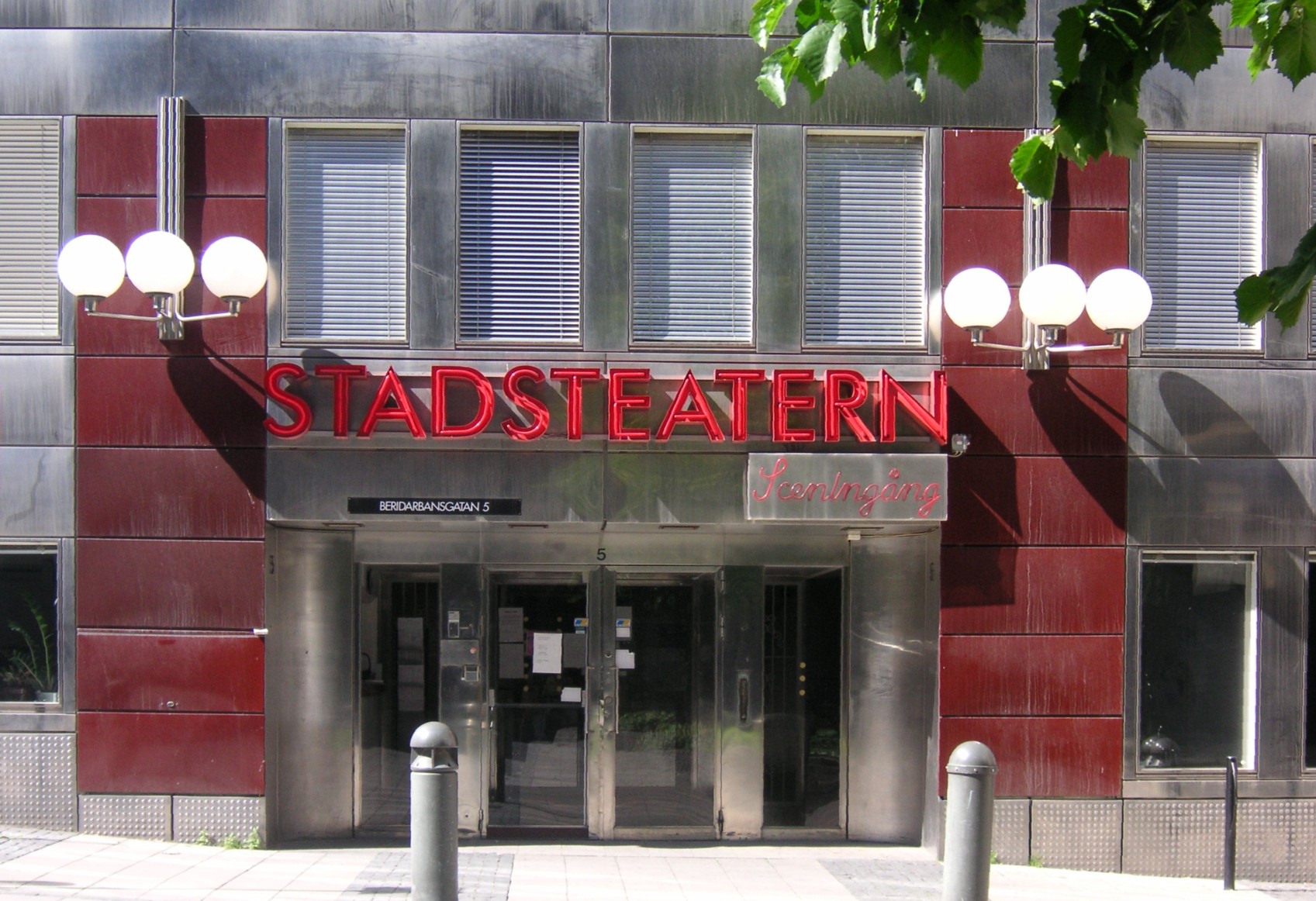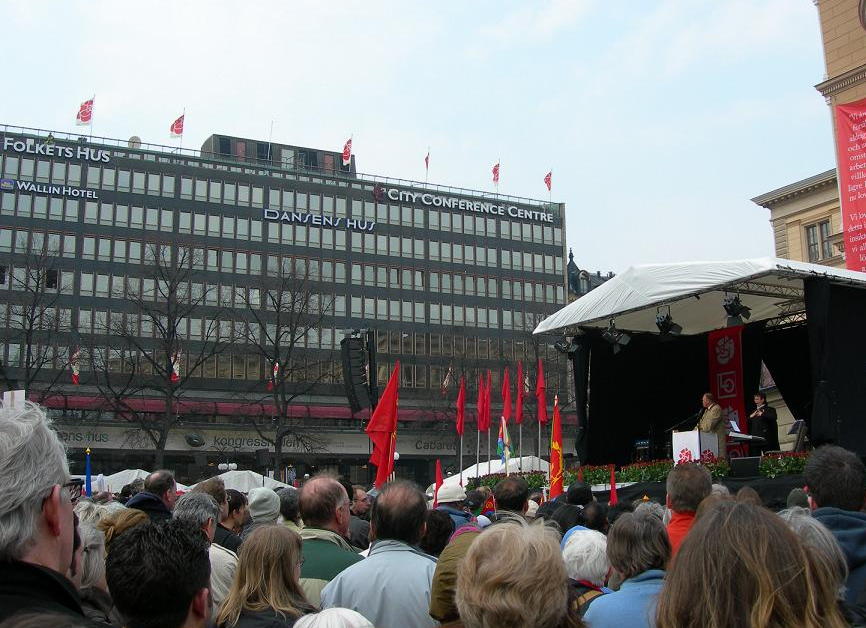|
Stockholm City Theatre
Stockholm City Theatre () is a live performance theatre located in Stockholm, Sweden. The theatre is situated near the Sergel fountain and the Stockholm City roundabout. Location It is located in one of Stockholm's most popular public buildings, the cultural centre known as The House of Culture. Besides the theatre, Kulturhuset also includes small cafés, book shops, a bar and a restaurant, a library, various exhibitions, public debates, lectures, book signings, a small medieval museum, and workshops. Stockholms stadsteater was created in 1956 but the first performance was delayed until 1960. It had not yet been decided at that point where in the city the theatre would be situated so the Folkets hus building at Norra Bantorget, with a temporary stage, became the first solution. However, this "temporary solution" lasted for nearly thirty years until the autumn of 1990, when all activity finally moved to the present location at Sergels torg. The theatre is one of Sweden's ... [...More Info...] [...Related Items...] OR: [Wikipedia] [Google] [Baidu] |
The House Of Culture (Stockholm)
House of Culture (Swedish: Kulturhuset) is a cultural center situated to the south of Sergels torg in central Stockholm, Sweden. The House of Culture has been described as a symbol for Stockholm as well as of the growth of modernism in Sweden. Overview In 1965 the city's government announced an architectural competition won by modernist architect Peter Celsing (1920–1974). Kulturhuset is from most angles dominated by its concrete and glass façade structure, with the adjacent theatre building having a façade of stainless steel. The original intention had been for the museum of modern art Moderna Museet, to occupy large parts of the building, but the museum dropped out of the project in 1969. The first stage of the center was opened in 1971 (the western part, including the theatre). It was the temporary seat of the Riksdag, the Swedish Parliament, until 1983, while the Riksdag building was remodelled for a unicameral Unicameralism (from ''uni''- "one" + Latin ''camer ... [...More Info...] [...Related Items...] OR: [Wikipedia] [Google] [Baidu] |
Folkets Hus
People's Houses () were originally leisure and cultural centres built with the intention of making art and cultural appreciation available to the working classes. The first establishment of this type appeared in Tomsk, Russian Empire in 1882. Soon people's Houses became popular in England (1887, "People's Palace"), Scotland, Turkey and other European states. The term "people's house" (e.g., ''folkets hus'', ''casa del pueblo'', ''maison du peuple'', etc.) was further used in continental Europe for working-class public community centres, each of which often had associations with particular trade union organizations and political parties. Russian Empire The first People's House () was built in Tomsk in 1882, and several more were erected in the capital of Russia, St. Petersburg during that decade. By the beginning of the 20th century the capital supported about 20 People's Houses: these provided entertainment, educational clubs for middle-class intelligentsia, petty officials, st ... [...More Info...] [...Related Items...] OR: [Wikipedia] [Google] [Baidu] |
Norra Bantorget
Norra Bantorget ("Northern Railway Square") is an area in central Stockholm, named after the location where the first Stockholm Norra Station was built. It is the traditional Social Democratic grounds of the Swedish capital. It is the location of the LO headquarters, the Swedish Trade Union Confederation. At Norra Bantorget is also the ''Workers Movement's Archive and Library'', and '' Folkets hus'' (where Russian social democrats held their Fourth Congress in 1906). There are several monuments of working class leaders erected at Norra Bantorget, including a statue of August Palm and the Branting Monument. A street in the area is named after Olof Palme. Norra Bantorget is a traditional gathering spot for demonstrations, such as the ones arranged by the Social Democrats on May Day May Day is a European festival of ancient origins marking the beginning of summer, usually celebrated on 1 May, around halfway between the Northern Hemisphere's March equinox, spring equinox an ... [...More Info...] [...Related Items...] OR: [Wikipedia] [Google] [Baidu] |
Sergels Torg
Sergels torg ("Sergel's Square") is a major public square in Stockholm, Sweden, constructed in the 1960s and named after 18th-century sculptor Johan Tobias Sergel, whose workshop was once located north of the square. Overview Sergels torg has a dominant west-to-east axis and is divided into three distinct parts: # A sunken pedestrian plaza furnished with a triangular-colored floor pattern (colloquially referred to as ''Plattan'', "The Slab") and a wide flight of stairs leading up to the pedestrian street Drottninggatan, connecting south to Stockholm Old Town and north to Kungsgatan. The triangular pattern of the square is featured on the seats of C30 and refurbished C20 trains of the Stockholm metro. # This plaza is partly overbuilt by a roundabout centered on a glass obelisk and by the concrete decks of three major streets. # North of this traffic junction is a considerably smaller open space overlooked by the high-rise façade of the fifth Hötorget Building from whe ... [...More Info...] [...Related Items...] OR: [Wikipedia] [Google] [Baidu] |
Royal Dramatic Theatre
The Royal Dramatic Theatre (, colloquially ''Dramaten'') is Sweden's national stage for "spoken drama", founded in 1788. Around one thousand shows are put on annually on the theatre's five running stages. The theatre has been at its present location in the Art Nouveau building at Nybroplan, Stockholm, since 1908. The theatre was built by the architect Fredrik Lilljekvist. Famous artists like Carl Milles and Carl Larsson were involved in making the decorations, and some of the interior decorations were made by Prince Eugen. The theatre's acting school, the Royal Dramatic Training Academy, produced many actors and directors who would go on to be famous, including Gustaf Molander (who also taught there), Alf Sjöberg, Greta Garbo, Vera Schmiterlöw, Signe Hasso, Ingrid Bergman, Gunnar Björnstrand, Max von Sydow, and Bibi Andersson. The school was split off as a separate institution in 1967 (see Swedish National Academy of Mime and Acting). History 17th and 18th ce ... [...More Info...] [...Related Items...] OR: [Wikipedia] [Google] [Baidu] |
Helena Bergström
Helena Kristina Bergström Nutley (; born 5 February 1964) is a Swedish actress and film director. From an acting family, she began her career in 1982. She has appeared on the stages of the Royal Dramatic Theatre (''Dramaten'') and the Stockholm City Theatre, but is best known for her work in films. '' The Women on the Roof'' is considered a breakout role for her. Her most awarded film is '' The Last Dance'', for which she received the Guldbagge Award for Best Actress in a Leading Role and Festival Awards in Montreal and Istanbul. Her husband, Colin Nutley, has directed her in several movies. In 2007, she directed for the first time for the film ''Mind the Gap''. She is also a screenwriter and a singer. Early and personal life Bergström was born in Kortedala, Gothenburg, the daughter of actress Kerstin Widgren and Hans Bergström, a director and actor. Her maternal grandfather, Olof Widgren, was also an actor. Bergström studied in Mississippi in the United States as an e ... [...More Info...] [...Related Items...] OR: [Wikipedia] [Google] [Baidu] |
Göran Ragnerstam
Göran Axel Ragnerstam (born 7 November 1957 ) is a Swedish actor. Ragnerstam was born in Stockholm; he grew up in Södermalm and later in Vällingby. His father was interested in theatre and acted out for his children. He encouraged Ragnerstam to move on to an acting course. Ragnerstam took part in plays in primary school primary education and secondary school. After that he worked on Posten AB, before he did military service conscription. An ad about training to be an actor got him to study at Kulturama, and after that he studied at NAMA in Malmö 1981–1984. After that he was involved in the Gothenburg City Theatre. Ragnerstam has also worked with Lars Norén. Ragnerstam was married to Carina Boberg and he is a cousin of author Bunny Ragnerstam. Filmography * 2017 – '' Jordskott II'' * 2017 – '' Vår tid är nu'' * 2016 – '' A Serious Game'' * 2015 – '' Jordskott'' * 2010 – '' Tusen gånger starkare'' * 2009 – ''Morden'' * 2007 – '' Arn – The Knig ... [...More Info...] [...Related Items...] OR: [Wikipedia] [Google] [Baidu] |
Ingvar Hirdwall
Lars Ingvar Hirdwall (5 December 1934 – 6 April 2023) was a Swedish actor. In Sweden he is best known for his role in the Martin Beck film series; internationally he was perhaps best known for his role as the lawyer Dirch Frode in the ''Millennium'' films. Characters One of the country's most prolific stage and film actors, he is probably most widely recognised for his two heterogeneous roles in the Martin Beck universe; as the eponymous killer in Bo Widerberg's '' The Man on the Roof'' in 1976, and the recurrent role as "The Neighbor" in the mass produced film series, a rambunctious raconteur who frequently interacts with the titular police investigator for the purpose of comic relief. He also had a role in the film adaptation of Stieg Larsson's ''Millennium'' series as the lawyer Dirch Frode, and starred as various colourful characters in Lars Molin's comedies. Career Hirdwall was born in Stockholm, and was educated at Gothenburg City Theatre stage school 1957–1960. Si ... [...More Info...] [...Related Items...] OR: [Wikipedia] [Google] [Baidu] |
Sven Wollter
Sven Justus Fredrik Wollter (11 January 1934 – 10 November 2020) was a Swedish actor, writer, and political activist. Wollter is one of the most renowned Swedish actors, he was awarded Best Swedish actor twice. In his native country, he became widely known through his role as Madame Flod's son Gusten in Swedish Television's adaption of '' The People of Hemsö'' by August Strindberg in 1966. Later he had several notable roles, including in 1976 when he played Detective Sergeant Lennart Kollberg in Bo Widerberg's film '' The Man on the Roof''. For international viewers, he is best known for his role Victor in the dramatic film '' The Sacrifice'' by Andrei Tarkovsky, and for a wider television audience as the retired Detective Chief Inspector Van Veeteren in the cinematic adaptations of Håkan Nesser's police novels. Biography Sven Wollter was born in Gothenburg, Sweden. He was the son of editor Kjell Wollter (1884–1950) and Elsa, née Ekwall (1905–1980). After studying a ... [...More Info...] [...Related Items...] OR: [Wikipedia] [Google] [Baidu] |
Ann Petrén
Ann Louise Maria Petrén (born 25 May 1954) is a Swedish actress. She has been a member of the permanent ensemble at Stockholm City Theatre since 1988. Early life and education Ann Louise Maria Petrén was born 25 May 1954 in Västerås to and Maud Jacobsson. Her family was wealthy. She was educated at Malmö Theatre Academy from 1976–1979. Career In 1988, she became a permanent member of the ensemble at Stockholm City Theatre. Her first role was in a production of Staffan Göthe's A Stuffed Dog. In 2003, she played Anita in . Writing for The New York Times, Stephen Holden wrote, "Petrén's avenging demon, in particular, is as frightening a surrogate for every wife who has been dumped for a younger woman as the screen has produced." She received a Guldbagge Award for her role as Anita in the film , and also the Jarl Kulle-scholarship and the award of Swedish Section of International Association of Theatre Critics. In 2011, Petrén received a "Guldbagge" for her ro ... [...More Info...] [...Related Items...] OR: [Wikipedia] [Google] [Baidu] |



